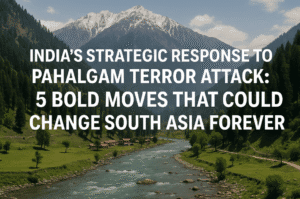India’s Strategic Response to Pahalgam Terror Attack: 5 Bold Moves That Could Change South Asia Forever
The terror attack in Pahalgam, Jammu and Kashmir, which claimed 26 lives, has triggered a bold response from India, blending military readiness, diplomatic pressure, and strategic focus on Pakistan. India has suspended the Indus Water Treaty and halted visa services for Pakistan, signaling a diplomatic offensive aimed at isolating Islamabad. Military strategists advocate for precision strikes using advanced drones and enhanced intelligence, reducing escalation risks while targeting terror camps.
Amid Pakistan’s internal crisis, the attack is seen as a tactic to divert attention from economic instability. PM Modi’s rhetoric bolsters his domestic image, but his government faces the challenge of balancing escalation with international diplomacy. The regional implications are significant, as India’s actions may reshape South Asia’s geopolitical dynamics, including water as a weapon and China’s cautious stance. Moving forward, India’s response will depend on intelligence accuracy, global support against terror groups, and domestic cohesion to prevent communal strife in Kashmir.

India’s Strategic Response to Pahalgam Terror Attack: 5 Bold Moves That Could Change South Asia Forever
The devastating terror attack in Pahalgam, Jammu and Kashmir, which claimed 26 lives, has reignited India’s resolve to confront cross-border terrorism with a multi-pronged strategy. As Prime Minister Narendra Modi vowed to “hunt down” perpetrators and their backers, New Delhi’s response blends aggressive diplomacy, military readiness, and a sharp focus on Pakistan’s internal dynamics. Here’s an analysis of India’s evolving approach and its broader implications.
Diplomatic Offensive: Turning Up the Heat
India’s immediate steps include suspending the Indus Water Treaty—a landmark 1960 agreement that governs water sharing with Pakistan. This move, while escalatory, underscores India’s leverage over a critical resource for Pakistan’s agriculture and economy. By halting visa services for Pakistani nationals, New Delhi also signals a freeze in bilateral engagement, isolating Islamabad diplomatically. These measures aim to pressure Pakistan’s leadership, already grappling with economic turmoil and political instability, to curb terror infrastructure on its soil.
Military Options: Precision Over Provocation
While the 2019 Balakot airstrikes demonstrated India’s willingness to strike deep inside Pakistan, military strategists now emphasize calibrated retaliation. Retired Lt Gen DS Hooda, architect of the 2016 surgical strikes, highlights India’s upgraded capabilities: attack drones and precision-guided munitions enable cross-border strikes without boots on the ground. This approach minimizes escalation risks while maximizing psychological impact.
Key considerations include:
- Drone Technology: India’s acquisition of advanced drones (e.g., U.S.-made MQ-9B) allows real-time surveillance and targeted strikes on terror camps in Pakistan-occupied Kashmir.
- Domestic Counterterror Ops: Enhanced intelligence networks and rapid-response units aim to neutralize infiltrators early, reducing reliance on cross-border action.
- Deterrence Posture: Publicizing military readiness—as seen in Modi’s rally speech—serves as both domestic reassurance and a warning to adversaries.
Pakistan’s Internal Strife: A Catalyst for Provocation?
Indian security assessments link the Pahalgam attack to Pakistan Army Chief Gen Asim Munir’s efforts to consolidate power amid the country’s economic freefall. With inflation soaring and public discontent mounting, analysts suggest the military may be stoking tensions with India to divert attention. The attack’s sectarian targeting (reportedly based on victims’ religious identity) further aligns with historic tactics to destabilize Kashmir’s social fabric.
Modi’s Political Calculus
PM Modi’s unequivocal rhetoric—“raze terrorists’ havens to the ground”—resonates with domestic audiences ahead of elections, reinforcing his strongman image. However, the government faces a delicate balance: excessive escalation could alienate international allies, while inaction risks eroding public trust. The emphasis on “tracking backers to the ends of the earth” hints at covert operations, possibly leveraging global intelligence partnerships to sanction terror financiers.
Regional Implications
India’s actions could reshape South Asia’s geopolitical landscape:
- Water as a Weapon: Suspending the Indus Treaty risks humanitarian fallout in Pakistan, potentially drawing UN scrutiny. Yet, it underscores India’s readiness to weaponize resources in asymmetric conflicts.
- China’s Role: Beijing, a key Pakistan ally, may mediate privately but is unlikely to openly endorse Indian retaliation, given its own territorial disputes with India.
- U.S. Stance: Washington’s counterterror alignment with India provides tacit support, though it may urge restraint to avoid regional instability.
The Road Ahead
India’s response will hinge on three factors:
- Intelligence Accuracy: Pinpointing terror cells without civilian casualties is critical to maintaining moral high ground.
- Global Diplomacy: Garnering international consensus against Pakistan-based terror groups, notably Jaish-e-Mohammed, remains pivotal.
- Domestic Cohesion: Preventing communal polarization in Jammu and Kashmir is essential to thwarting Pakistan’s narrative of Kashmir as a “Muslim struggle.”
The Pahalgam attack has thrust India into a familiar yet evolving battlefield. By merging diplomatic coercion with cutting-edge military tactics, New Delhi aims to rewrite the rules of engagement—deterring future attacks while signaling that the era of impunity for cross-border terrorism is over. The world watches as India navigates this tightrope, where restraint and resolve must coexist.
You must be logged in to post a comment.